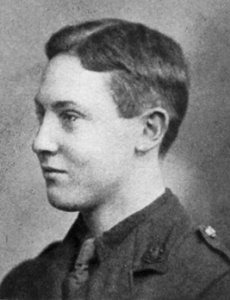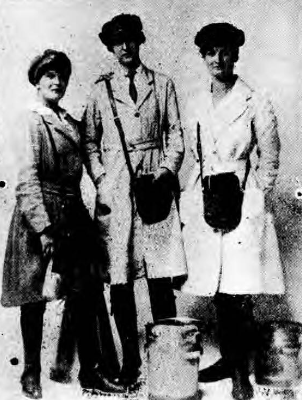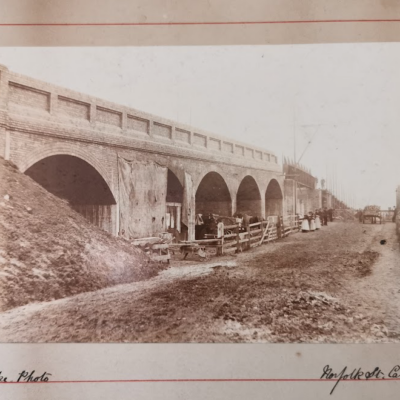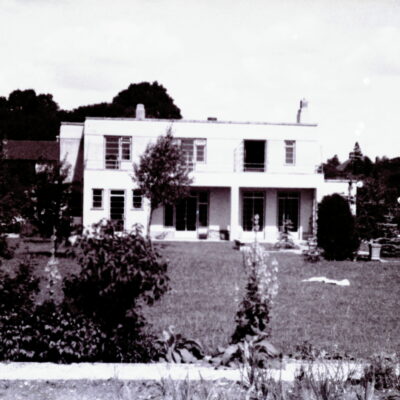Search by topic
- archaeology
- Building of Local Interest
- chapel
- charity
- church
- crime
- dressmaker
- fire
- Great Eastern Railway
- Listed building
- Mapping Relief
- medieval
- oral history
- poverty
- Public House
- Religious House
- Roman
- scholar
- school
- Then and Now
- tudor
- women
- work
- world war one
- world war two
Search by text
The Great War in St John’s Parish: Hills Road (South) – south of the railway line
World War One - Hills Road
Since 1914 many of the large houses in Hills Road (South) beyond Homerton College and St John’s Church have changed little. However much of the area between Homerton College and the railway line has been completely transformed, in particular Homerton Street and Purbeck Road and the adjacent stretches of Hills Road. By the start of the Great War there were large houses all the way up to the junction with Long Road. Not all of the houses we see today had been built and there were frequent gaps towards the south end. As with other local roads, before WWI the houses were generally identified by name; from this time the use of numbers seems to have become more widespread. Unlike other roads, where the house names have usually survived, in Hills Road they have virtually all been erased and therefore identification of the houses is a more difficult than elsewhere in the parish.
Around 1914 there were approximately 36 households on the west side and 46 on the east. Fourteen men from these families saw service; five did not return home. It is obvious that Hills Road families sent considerably more officers into service than other streets; these were boys who had been to the independent schools and often university. It also seems that a number of soldiers were billeted in these large house from the evidence of marriages with domestic servants and others.
Just south of Homerton Street was no.154, the Babraham Dairy where Samuel and Elizabeth Noble lived with their two sons. The youngest, Percy, born 1896, was a bookstall assistant. He joined up in June 1915 and joined the Army Cyclist Corps. On 30/11/1916 he was punished with a fine of two days pay for the loss of kit on active service. In January 1917 he was confined to barracks for two days for having an untidy berth and dirty mess tin. He contracted influenza in June 1918 but survived the war to marry in 1923, living until 1954.
His older brother Samuel, born 1891, a hosier’s porter, was a private in the 7th Bttn. Royal West Surrey Regiment. In 1915 he married Hilda and moved to 22 Marshall Road but was killed in action on on the Somme in 28/9/1916. He was buried in Mill Road Cemetery and his widow received £1 19s 9d War Gratuity in 1919.
158 was the address of Langford and Sons. We know that a Walter S Archdale of this address, a sergeant in the 1st Cambridgeshire Regiment, baptised his daughter on 23/1/16 at St John’s, but nothing else for certain.
170 Hills Road (originally Purbeck Road): Gerald H S Hitch, born 1890, a captain in the Army Service Corps, married Phyllis Riley a teacher from Swansea on 18/1/15 at St John’s. He died in Wandsworth on 10/2/1919, cause unknown but possibly influenza.
188 (The Lodge, Homerton College): Gerald Leslie Willers, b. 1892, was a warehouseman. He volunteered for the Red Cross in 1918 in hospital convoy duty. His father, Samuel, was a head gardener, presumably at Homerton College.
Homerton College: The principal, Miss Mary Allan, was fined 10s for light showing from a classroom at the college on 3/5/16. Lighting was carefully policed at this time as other reports show.
230 ‘Alfriston’: Dennis Digges La Touche, born 1895, was the eldest son of Thomas Henry and Anna Digges La Touche. Thomas Henry was a distinguished geologist, a member of the Geological Survey of India, who died in 1938. Dennis had been to school at Shrewsbury was awarded a scholarship at Corpus Christi College Cambridge University in 1913 but gave this up to enlist. He reached the rank of captain in the 8th Bttn. Welsh Regiment. He died 8/8/1915 at the Dardanelles.
238 St Colum: Harold Arthur Gittus, b. 1893, served as a lieutenant in the Cambridge Regiment. His commission was announced in the London Gazette 22.7.1915. He was previously a private in the Suffolk Yeomanry.
246 Lathom: Nellie Raby was a nurse living at this address. She married Reginald H Gibson of Ainsworth Street, a motor mechanic, who had enlisted September 1914 and become a private in the ASC (Mech. Transport).
246 N Vinter [probably Ada Louise b.1877, wife of Ernest] volunteered for the Red Cross from 1916-1919 at the 1st Eastern General.
248 Dalkeith (Smalldene): Arthur Hugh Bales Chaplin, b. 1876, worked in his father’s drapery business as a buyer. By 1911 he was married to Amelia with a daughter. At some stage he became a partner in Robert Sayle. Before the war he was a lieutenant in the Cambridgeshire Volunteer Regiment. He played an active role in the recruiting rally which took place in Cambridge in January 1914. He applied for a commission and joined 1st Bttn. Cambridge Regiment as a Captain and went to France in early 1915. He was invalided home with double pneumonia within a month or so. He returned to France in February 1916 and was promoted to major on 31st March 1916. He was wounded in action on 14th March 1917 and was admitted to hospital in Boulogne with wounds in the left arm, leg and foot. He was brought over to England on Easter Monday and taken to the Countess of Ridley’s Hospital at 10 Carlton House Terrace in London, where he died on 21st May 1917 aged 41. He was buried in Trumpington cemetery.
250 Halesowen:
Ernest Saville Peck (1866-1955) was the son of chemist George Peck and attended The Perse School and Fitzwilliam House. He became an apprentic at his father pharmacy at 30 Trumpington Street and then studied chemistry at Cambridge University. He was a member of the Territorial Division of the cambridgeshire regiment and at the outbreak of war, as a captain, was instrumental in the formation of a 2nd Reserve Battalion to replace casualties in the 1st battalion in France. promoted to Major in 1915, he became an expert in chemical warfare and established the Anti-Gas school at Halton Camp. In 1918 he travelled to the USA and advised the US Army Gas School on training troops.
Florence Treadgold volunteered for the Red Cross and worked from 1914-1919 as a ward help at the Cintra Terrace and Wordsworth VAD hospitals.
291 Raylands:
Frederick Hiam moved with his family to Cambridgeshire in 1910 and by 1918 had invested a quarter of a million pounds in buying land in East Anglia. because of his connections. Fred was made Honorary Director of Vegetable Supplies during the First World War. He was knighted in 1924 and died in 1938. He founded Frederick Hiam Ltd and the company web site has a summary of his career.
John Webb volunteered for the Red Cross from 1916-17 as an orderly at Swavesey VAD hospital.
289 Glebe Lodge: William P Cutlack, b.1882 was a Lt. Colonel in the 1st Cambridgeshire Regiment and served in France from September 1916. He had married Dora in 1882 and they baptised their son on 8/5/15 at St John’s. There is a detailed biography of William Cutlack on the Cambridgeshire Regiment website.
281 Nereton: Francis H A Thoday, b. 1883, served as a 2nd Lieut. with the City of London Royal Fusiliers from April 1915 in France. He married Gladys Minnie, age 21, of 281 Hills Road on 6/11/15 at St John’s. His father Herbert was a building contractor living at 96 Hills Road.
281 Nereton: Emma Parsons volunteered for the Red Cross from 1916-1919 mending for wounded soldiers.
267 Elm House: On 29/12/16 the owners were fined 5s for light showing from the lavatory window.
263 Walter Thomas Layton, 1st Baron Layton, 1884-1966, was an economist, editor, newspaper owner and Liberal politican. He lectured at Trinity College in 1908 and was a fellow of Caius from 1909 to 1914. He worked for the Ministry of Munitions during WWI and then, in WWII held positions in the Ministry of Supply and the Ministry of Production. He was editor of the Economist for many years and also editorial director of the new News Chronicle from 1930-1940.
251 Kenfig/Elstow: Philip Franklen-Evans born 1899, died 18/9/1918/ He was a second lieutenant in the Durham Light Infantry. He fell near St Quentin and died of his wounds. His father was a medical researcher.
239 Pettistree: Stewart Athole Wight volunteered for the Red Cross from 1914-1918 as a masseuse at the Histon VAD hospital. Born in 1884, he was an electro therapeutist and married Edith Kathleen Inman in 1912. He volunteered in December 1915 and joined the Inns of Court OTC in March 1918 from which he was discharged in March 1919 with a broken leg.
191 Nenedale: Frederick Arnold, b.1877 Whittlesford, was a master butcher like his father. He was based with the cadet company at Aldershot initially, then, in 1917, he was appointed to a temporary commission in the ASC. He had married Agnes in 1900 in Chesterton but seems to have moved to South Africa at some point from where he returned in 1916 with his family.
183 Beechdene: Edwin Robert W Kett, b. 1889, was one of eight children of William Kett, the stone mason, and his wife Elizabeth. They had previously lived in Clacton Villa, Hartingdon Grove. He joined up as a private in the 2nd Bttn. East Lancashire regiment and was killed in action in France on 9/5/1915.
163 Mavis House (Bank): Eliza Allen was a domestic servant at this address when she married Frederick Hagger, a private with the 3rd Bttn. Essex Regiment.
The number of the house named ‘Guy Harling’ is unknown at present. In 1901 it was lived in by members of the Butler family. George Guy Butler was a student at Emmanuel College. He studied medicine at St Thomas’s Hospital and was a Captain in the RAMC in WWI and was awarded the MBE. He was later director of the Laboratory Dar-es-Salaam and bacteriologist Government Lymph Establishment, Ministry of Health.
159 Rathmore: This was the home of Mary E Jolley who in 1901 was living with her two sisters and their nephew, John A B Jolley, aged 5, son of a schoolmaster. He was educated at the Perse School and then St Catherine’s College. He served as a 2nd Lieut. in the 9th Lincolnshire Regiment. He was fatally wounded during the storming of the Hohenzollern Redoubt on 22/10/1915.
His brother, Graham C K Jolley, b.1893, a second lieutenant with 8th Duke of Wellington Regiment (later with theRGA) was wounded in the Dardanelles. He was being nursed at the Research Hospital at the time his brother died.
Contribute
Do you have any information about the people or places in this article? If so, then please let us know using the Contact page or by emailing capturingcambridge@
License
This work is licensed under CC BY-NC-SA 4.0










